Quantifying Ecological Dynamics and Anthropogenic Dominance in Drylands: A Hybrid Modeling Framework Integrating MRSEI and SHAP-Based Explainable Machine Learning in Northwest China
Abstract
1. Introduction
2. Study Area and Datasets
2.1. Study Area
2.2. Datasets
3. Methods
3.1. MRSEI Model
3.2. Spearman’s Rank Correlation Analysis
3.3. T-S Estimator and M-K Test
3.4. Machine Learning
3.4.1. Machine Learning Models
3.4.2. Evaluation of Model Indicators
3.4.3. Interpretable Machine Learning SHAP Models
4. Results
4.1. Effectiveness of the MRSEI
4.2. Applicability of the MRSEI
4.3. Characteristics of Spatial and Temporal Changes in Ecological Quality
4.3.1. Spatial Distribution Characteristics of the MRSEI
4.3.2. Temporal Distribution Characteristics of the MRSEI
4.4. Trend Analysis of Ecological Quality
4.5. Analysis of the Driving Factors of the MRSEI
4.5.1. Comparison of Machine Learning Models
4.5.2. Interpretable Machine Learning Model Analysis
5. Discussion
5.1. Ecological Environment Quality Assessment
5.2. Analysis of Ecological Environment Driving Mechanisms
5.3. Limitations and Future Work
6. Conclusions
- (1)
- This study innovatively incorporated a salinity index (CSI) into the RSEI to construct the MRSEI. Its effectiveness for ecological assessment in arid and semi-arid regions was validated through PCA, correlation analysis, spatial comparisons, and contrast/entropy metrics. The MRSEI preserved the multi-index integration advantage of the RSEI (with a mean PC1 contribution of 79.96%) while achieving superior characterization of surface detail. Furthermore, GLCM texture analysis further confirmed the MRSEI’s enhanced performance in both entropy and contrast metrics, indicating stronger spatial heterogeneity representation capabilities.
- (2)
- The MRSEI-based assessment of Yinchuan City’s ecological quality from 2014 to 2023 revealed a distinct spatial pattern of “higher in the northwest and lower in the southeast”. High-quality zones were primarily distributed in the western Helan Mountains and the integrated urban/rural development demonstration zone, while comparatively poorer ecological conditions were observed in the core functional zone of the provincial capital, the Helan Mountains ecological corridor, and the eastern eco-economic pilot zone. During 2014–2023, ecological quality grades were predominantly “Fair” and “Moderate”, exhibiting a distinct “W”-shaped temporal fluctuation pattern.
- (3)
- Trend analysis using the T–S estimator and M–K test indicated that “No Significant Change” dominated ecological trends in Yinchuan during 2014–2023, accounting for 7609.23 km2 (87.92%) of the total area. Improved areas accounted for 1.28% of the total area, comprising “Extremely Significant Improvement” (21.1959 km2, 0.24%) and “Significant Improvement” (89.8398 km2, 1.04%). Degraded areas represented 10.80%, including “Extremely Significant Degradation” (143.8580 km2, 1.66%) and “Significant Degradation” (790.6590 km2, 9.14%). The substantial predominance of degraded areas indicated an overall ecological deterioration during 2014–2023.
- (4)
- To explore ecological driving mechanisms, this study applied interpretable machine learning, combining the LightGBM model with SHAP analysis using ten representative natural and anthropogenic factors. LightGBM demonstrated optimal performance (R2 = 0.6918, lowest MAE and RMSE), establishing it as the superior model. SHAP analysis identified LULC, DEM, and NPP as dominant factors: (a) cropland and forest exerted positive effects; (b) DEM (1100–1150 m) significantly enhanced the MRSEI; (c) NPP > 175 g C/m2/yr progressively improved the MRSEI. Interaction effects revealed the highest MRSEI values when NPP > 175 g C/m2/yr and DEM < 1140 m.
Author Contributions
Funding
Data Availability Statement
Acknowledgments
Conflicts of Interest
References
- Yu, S.; Zhang, X.; Wang, Y.; Shen, Y. Review of research on the impacts of climate change on staple grain crops in the three provinces of Northeast China. Chin. J. Eco-Agric. 2024, 32, 970–985. [Google Scholar]
- Jiang, Z.; Yang, Z.; Yang, Q.; Zuo, H.; Wang, Z.; Wang, J.; Tian, L. Analysis on Dynamic Change of Desertification in Kubuqi Desert During 2000–2023 Based on Landsat 8. Bull. Soil Water Conserv. 2024, 44, 118–128. [Google Scholar]
- Han, S.; Wang, Q. Response of boreal forest ecosystem to global climate change: A review. J. Beijing For. Univ. 2016, 38, 1–20. [Google Scholar]
- Zhang, W.; Du, P.; Guo, S.; Lin, C.; Zheng, H.; Fu, P. Enhanced remote sensing ecological index and ecological environment evaluation in arid area. Natl. Remote Sens. Bull. 2023, 27, 299–317. [Google Scholar] [CrossRef]
- Xu, Y.; Zhou, H. A Preliminary Study on Advances in Assessment of Eco-environmenttal Quality in China. Arid Land Geogr. 2003, 26, 166–172. [Google Scholar]
- Lingtong, D.U. Heat island effect study of Yinchuan based on landsat ETM + Data. Sci. Surv. Mapp. 2008, 33, 169–171. [Google Scholar]
- Yuan, J.; Zhao, H.; Liu, X.; Li, H.; Jiang, D.; Zhao, C.; Xing, L.; Luo, X.; Wang, R.; Wang, C. Driving force analysis and ecological assessment of spatiotemporal changes in vegetation cover in the Kunlun Mountains from 2000 to 2020. Geol. China 2024, 51, 1822–1838. [Google Scholar]
- Fang, C.; Zhou, C.; Gu, C.; Chen, L.; Li, S. Theoretical analysis of interactive coupled effects between urbanization and eco-environment in mega-urban agglomerations. Acta Geogr. Sin. 2016, 71, 531–550. [Google Scholar] [CrossRef]
- Xu, H. A remote sensing urban ecological index and its application. Acta Ecol. Sin. 2013, 33, 7853–7862. [Google Scholar]
- Yue, H.; Liu, Y.; Li, Y.; Lu, Y. Eco-Environmental Quality Assessment in China’s 35 Major Cities Based On Remote Sensing Ecological Index. IEEE Access 2019, 7, 51295–51311. [Google Scholar] [CrossRef]
- Xiong, Y.; Xu, W.H.; Lu, N.; Huang, S.D.; Wu, C.; Wang, L.G.; Dai, F.; Kou, W.L. Assessment of spatial—Temporal changes of ecological environment quality based on RSEI and GEE: A case study in Erhai Lake Basin, Yunnan province, China. Ecol. Indic. 2021, 125, 107518. [Google Scholar] [CrossRef]
- Sun, C.; Li, J.L.; Liu, Y.C.; Cao, L.D.; Zheng, J.H.; Yang, Z.J.; Ye, J.W.; Li, Y. Ecological quality assessment and monitoring using a time-series remote sensing-based ecological index (ts-RSEI). Gisci. Remote Sens. 2022, 59, 1793–1816. [Google Scholar] [CrossRef]
- Liu, J.; Zhang, L.; Dong, T.; Wang, J.L.; Fan, Y.M.; Wu, H.Q.; Geng, Q.L.; Yang, Q.J.; Zhang, Z.B. The Applicability of Remote Sensing Models of Soil Salinization Based on Feature Space. Sustainability 2021, 13, 13711. [Google Scholar] [CrossRef]
- Wang, J.; Ma, J.-L.; Xie, F.-F.; Xu, X.-J. Improvement of remote sensing ecological index in arid regions: Taking Ulan Buh Desert as an example. Ying Yong Sheng Tai Xue Bao = J. Appl. Ecol. 2020, 31, 3795–3804. [Google Scholar] [CrossRef]
- Wang, Y.; Liu, P.; Liu, J.; Zhang, D.; Wang, L.; Huang, L. Analysis of Spatiotemporal Changes in Ecological Environment Quality of the Yellow River Delta Based on Modified Remote Sensing Ecological Index. J. Ecol. Rural Environ. 2024, 40, 1179–1190. [Google Scholar]
- Deng, W.; Wen, X.; Xu, H.; Duan, W.; Li, C. Analysis of regional development and its ecological effects:A case study of the Xiong’an New Area, China. Acta Ecol. Sin. 2023, 43, 263–273. [Google Scholar]
- Ariyasu, E.; Kakuta, S. Estimating Soil Salinity Using HISUI Hyperspectral Data in the Western Australian Wheatbelt. ISPRS Ann. Photogramm. Remote Sens. Spat. Inf. Sci. 2024, 10, 21–27. [Google Scholar] [CrossRef]
- Wang, N.; Peng, J.; Chen, S.C.; Huang, J.Y.; Li, H.Y.; Biswas, A.; He, Y.; Shi, Z. Improving remote sensing of salinity on topsoil with crop residues using novel indices of optical and microwave bands. Geoderma 2022, 422, 115935. [Google Scholar] [CrossRef]
- Allbed, A.; Kumar, L.; Aldakheel, Y.Y. Assessing soil salinity using soil salinity and vegetation indices derived from IKONOS high-spatial resolution imageries: Applications in a date palm dominated region. Geoderma 2014, 230–231, 1–8. [Google Scholar] [CrossRef]
- Yang, S.; Han, H. Quantitative analysis of NDVI driving factors in Gansu Province based on geodetector. J. Gansu Agric. Univ. 2019, 54, 115–123. [Google Scholar]
- Nie, T.; Dong, G.; Jiang, X.; Lei, Y.; Gao, S.; He, J. Temporal and spatial variations and driving force analysis of NDVI in Henan Province based on Geodetector. Chin. J. Ecol. 2024, 43, 273–281. [Google Scholar]
- Zhang, R.; Li, C.; Yao, S.; Li, W. Study on the change factors of construction land in Taiyuan by integrating geographic detector and geographically weighted regression. Bull. Surv. Mapp. 2022, 106–109, 119. [Google Scholar]
- Renyang, Q.; Lian, Y.; Li, H.; Gao, H.; Dong, J.; He, M. Spatial and temporal distribution of CO2 concentration in mainland China and its influencing factors. China Environ. Sci. 2023, 43, 1919–1929. [Google Scholar]
- Zhang, S.; Nie, Y.; Zhang, H.; Li, Y.; Han, Y.; Liu, X.; Wang, B. Spatiotemporal Variation of Vegetation NDVI and its Driving Forces in Inner Mongolia Based on Geodetector. Acta Agrestia Sin. 2020, 28, 1460–1472. [Google Scholar]
- Shi, Z.; Xie, H.; Wang, Z.; Hu, X.; Wang, X.; Xie, X.; Lin, H.; Liu, X. Analysis of spatiotemporal heterogeneity of habitat quality and their driving factors based on optimal parameters-based geographic detector for Fuzhou City, China. J. Environ. Eng. Technol. 2023, 13, 1921–1930. [Google Scholar]
- Tayier, K.; Li, H.; Aierken, G.; Yin, Z.; Wu, H. Spatio-temporal Evolution and Prediction of Carbon Emissions in Urumqi Region Based on FLUS and Grey Prediction Model. J. Soil Water Conserv. 2023, 37, 214–226. [Google Scholar]
- Zhang, L.Y.; Li, X.; Liu, X.H.; Lian, Z.Y.; Zhang, G.Z.; Liu, Z.Y.; An, S.X.; Ren, Y.X.; Li, Y.L.; Liu, S.D. Dynamic monitoring and drivers of ecological environmental quality in the Three-North region, China: Insights based on remote sensing ecological index. Ecol. Inform. 2025, 85, 102936. [Google Scholar] [CrossRef]
- Chen, L.F.; Zhang, H.; Zhang, X.Y.; Liu, P.H.; Zhang, W.C.; Ma, X.Y. Vegetation changes in coal mining areas: Naturally or anthropogenically Driven? Catena 2022, 208, 105712. [Google Scholar] [CrossRef]
- Sun, Z.; Xie, S. Spatiotemporal variation in net primary productivity and factor detection in Yunnan Province based on geodetector. Chin. J. Ecol. 2021, 40, 3836–3848. [Google Scholar]
- Huang, X.; Peng, S.-Y.; Wang, Z.; Huang, B.-M.; Liu, J. Spatial heterogeneity and driving factors of ecosystem water yield service in Yunnan Province, China based on Geodetector. Ying Yong Sheng Tai Xue Bao = J. Appl. Ecol. 2022, 33, 2813–2821. [Google Scholar] [CrossRef]
- Mu, F.; Huang, Q.; Chen, L. Eco-environmental Quality Driving Force Detection Using Optimized Geographic Detector. Res. Soil Water Conserv. 2024, 31, 440–449. [Google Scholar]
- Asri, A.K.; Lee, H.Y.; Chen, Y.L.; Wong, P.Y.; Hsu, C.Y.; Chen, P.C.; Lung, S.C.C.; Chen, Y.C.; Wu, C.D. A machine learning-based ensemble model for estimating diurnal variations of nitrogen oxide concentrations in Taiwan. Sci. Total Environ. 2024, 916, 170209. [Google Scholar] [CrossRef] [PubMed]
- Pelegrina, G.D.; Duarte, L.T.; Grabisch, M. A k-additive Choquet integral-based approach to approximate the SHAP values for local interpretability in machine learning. Artif. Intell. 2023, 325, 104014. [Google Scholar] [CrossRef]
- Li, Z.Q. Extracting spatial effects from machine learning model using local interpretation method: An example of SHAP and XGBoost. Comput. Environ. Urban Syst. 2022, 96, 101845. [Google Scholar] [CrossRef]
- Khan, N.M.; Rastoskuev, V.V.; Sato, Y.; Shiozawa, S. Assessment of hydrosaline land degradation by using a simple approach of remote sensing indicators. Agric. Water Manag. 2005, 77, 96–109. [Google Scholar] [CrossRef]
- Xiaolei, L.I.U.; Zhihao, Q.I.N. Comparative Analysis between NDWI and NDVI Indices in Regional Drought Monitoring. Remote Sens. Technol. Appl. 2007, 22, 608–612. [Google Scholar]
- Lobser, S.E.; Cohen, W.B. MODIS tasselled cap: Land cover characteristics expressed through transformed MODIS data. Int. J. Remote Sens. 2007, 28, 5079–5101. [Google Scholar] [CrossRef]
- Xu, H. A new index for delineating built-up land features in satellite imagery. Int. J. Remote Sens. 2008, 29, 4269–4276. [Google Scholar] [CrossRef]
- Liu, Y.X.; Wang, Y.L.; Peng, J.; Du, Y.Y.; Liu, X.F.; Li, S.S.; Zhang, D.H. Correlations between Urbanization and Vegetation Degradation across the World’s Metropolises Using DMSP/OLS Nighttime Light Data. Remote Sens. 2015, 7, 2067–2088. [Google Scholar] [CrossRef]
- Li, Y.M.; Li, Y.T.; Yang, X.; Feng, X.J.; Lv, S.B. Evaluation and driving force analysis of ecological quality in Central Yunnan Urban Agglomeration. Ecol. Indic. 2024, 158, 111598. [Google Scholar] [CrossRef]
- Amirataee, B.; Montaseri, M. The performance of SPI and PNPI in analyzing the spatial and temporal trend of dry and wet periods over Iran. Nat. Hazards 2017, 86, 89–106. [Google Scholar] [CrossRef]
- Chen, C.; Wang, L.Y.; Yang, G.; Sun, W.W.; Song, Y.Z. Mapping of Ecological Environment Based on Google Earth Engine Cloud Computing Platform and Landsat Long-Term Data: A Case Study of the Zhoushan Archipelago. Remote Sens. 2023, 15, 4072. [Google Scholar] [CrossRef]
- Garzón, M.B.; Blazek, R.; Neteler, M.; de Dios, R.S.; Ollero, H.S.; Furlanello, C. Predicting habitat suitability with machine learning models: The potential area of Pinus sylvestris L. in the Iberian Peninsula. Ecol. Model. 2006, 197, 383–393. [Google Scholar] [CrossRef]
- Chen, Y.; Zhao, Q.; Liu, Y.M.; Zeng, H. Exploring the impact of natural and human activities on vegetation changes: An integrated analysis framework based on trend analysis and machine learning. J. Environ. Manag. 2025, 374, 124092. [Google Scholar] [CrossRef]
- Ueda, K.; Suwa, H.; Yamada, M.; Ogawa, Y.; Umehara, E.; Yamashita, T.; Tsubouchi, K.; Yasumoto, K. SSCDV: Social media document embedding with sentiment and topics for financial market forecasting. Expert Syst. Appl. 2024, 245, 122988. [Google Scholar] [CrossRef]
- Segal, M.; Xiao, Y.Y. Multivariate random forests. Wiley Interdiscip. Rev. Data Min. Knowl. Discov. 2011, 1, 80–87. [Google Scholar] [CrossRef]
- Tian, S.; Guo, H.W.; Xu, W.; Zhu, X.T.; Wang, B.; Zeng, Q.H.; Mai, Y.Q.; Huang, J.H.J. Remote sensing retrieval of inland water quality parameters using Sentinel-2 and multiple machine learning algorithms. Environ. Sci. Pollut. Res. 2023, 30, 18617–18630. [Google Scholar] [CrossRef]
- Chen, J.J.; Du, H.Q.; Mao, F.J.; Huang, Z.H.; Chen, C.; Hu, M.C.; Li, X.J. Improving forest age prediction performance using ensemble learning algorithms base on satellite remote sensing data. Ecol. Indic. 2024, 166, 112327. [Google Scholar] [CrossRef]
- Wang, C.; Sheng, Q.Q.; Zhu, Z.L. Exploring Ecological Quality and Its Driving Factors in Diqing Prefecture, China, Based on Annual Remote Sensing Ecological Index and Multi-Source Data. Land 2024, 13, 1499. [Google Scholar] [CrossRef]
- Yang, Y.Z.; Meng, Z.J.; Zu, J.X.; Cai, W.H.; Wang, J.L.; Su, H.X.; Yang, J. Fine-Scale Mangrove Species Classification Based on UAV Multispectral and Hyperspectral Remote Sensing Using Machine Learning. Remote Sens. 2024, 16, 3093. [Google Scholar] [CrossRef]
- Tibshirani, R. Regression shrinkage and selection via the lasso: A retrospective. J. R. Stat. Soc. Ser. B-Stat. Methodol. 2011, 73, 273–282. [Google Scholar] [CrossRef]
- Qi, T.J.; Zhao, Y.; Meng, X.M.; Shi, W.; Qing, F.; Chen, G.; Zhang, Y.; Yue, D.X.; Guo, F.Y. Distribution Modeling and Factor Correlation Analysis of Landslides in the Large Fault Zone of the Western Qinling Mountains: A Machine Learning Algorithm. Remote Sens. 2021, 13, 4990. [Google Scholar] [CrossRef]
- Chen, H.; Covert, I.C.; Lundberg, S.M.; Lee, S.I. Algorithms to estimate Shapley value feature attributions. Nat. Mach. Intell. 2023, 5, 590–601. [Google Scholar] [CrossRef]
- Lundberg, S.M.; Erion, G.; Chen, H.; DeGrave, A.; Prutkin, J.M.; Nair, B.; Katz, R.; Himmelfarb, J.; Bansal, N.; Lee, S.I. From local explanations to global understanding with explainable AI for trees. Nat. Mach. Intell. 2020, 2, 56–67. [Google Scholar] [CrossRef]
- Xu, H.; Deng, W. Rationality Analysis of MRSEI and Its Difference with RSEI. Remote Sens. Technol. Appl. 2022, 37, 1–7. [Google Scholar]
- Wang, J.; He, J.; Qu, G.; Hou, J.; Wang, H. Temporal and spatial evolution of eco-environmental quality and its driving factors in Yinchuan city. Southwest China J. Agric. Sci. 2023, 36, 2780–2792. [Google Scholar]
- Zhang, X.; Chen, L.; Ma, Y.; Huang, Z.; Li, Y. Monitoring and evaluation of ecology and environment quality of Yinchuan City based on GIS and RS. J. Saf. Environ. 2021, 21, 2854–2864. [Google Scholar]
- Wang, B.; Yang, T.B. Assessing Impact of Land Use Change on the Ecosystem Service Value in Yinchuan City from 1980 to 2018. Sustainability 2021, 13, 8311. [Google Scholar] [CrossRef]
- Ma, Y.X.; Tashpolat, N. Remote Sensing Monitoring of Soil Salinity in Weigan River-Kuqa River Delta Oasis Based on Two-Dimensional Feature Space. Water 2023, 15, 1694. [Google Scholar] [CrossRef]
- Wu, X.; Wang, Z.; Fan, L.; Li, L. An applicability analysis of salinization evaluation index based on multispectral remote sensing to soil salinity prediction in Yinbei irrigation area of Ningxia. Remote Sens. Land Resour. 2021, 33, 124–133. [Google Scholar]
- Cao, L.; Ding, J.; Umut, H.; Su, W.; Ning, J.; Miao, C.; Li, H. Extraction and Modeling of Regional Soil Salinization Based on Data from GF-1 Satellite. Acta Pedol. Sin. 2016, 53, 1399–1409. [Google Scholar]
- Zhang, H.; Wang, W.; Song, Y.; Miao, L.; Ma, C. Ecological index evaluation of arid inflow area based on the modified remote sensing ecological index:a case study of Tabu River Basin at the northern foot of the Yin Mountains. Acta Ecol. Sin. 2024, 44, 523–543. [Google Scholar]
- Wu, D.; Jia, K.L.; Zhang, X.D.; Zhang, J.H.; Abd El-Hamid, H.T. Remote Sensing Inversion for Simulation of Soil Salinization Based on Hyperspectral Data and Ground Analysis in Yinchuan, China. Nat. Resour. Res. 2021, 30, 4641–4656. [Google Scholar] [CrossRef]
- Peng, J.; Liu, H.; Shi, Z.; Xiang, H.; Chi, C. Regional heterogeneity of hyperspectral characteristics of salt-affected soil and salinity inversion. Trans. Chin. Soc. Agric. Eng. 2014, 30, 167–174. [Google Scholar]
- Bai, Z.F.; Han, L.; Liu, H.Q.; Jiang, X.H.; Li, L.Z. Spatiotemporal change and driving factors of ecological status in Inner Mongolia based on the modified remote sensing ecological index. Environ. Sci. Pollut. Res. 2023, 30, 52593–52608. [Google Scholar] [CrossRef]
- Zhang, X.X.; Wang, X.X.; Li, W.P.; Wu, X.D.; Cheng, X.Q.; Zhou, Z.Y.; Ling, Q.; Liu, Y.D.; Liu, X.J.; Hao, J.M.; et al. Dynamic Monitoring and Analysis of Ecological Environment Quality in Arid and Semi-Arid Areas Based on a Modified Remote Sensing Ecological Index (MRSEI): A Case Study of the Qilian Mountain National Nature Reserve. Remote Sens. 2024, 16, 3530. [Google Scholar] [CrossRef]
- Feng, Z.; She, L.; Wang, X.; Yang, L.; Yang, C. Spatial and Temporal Variations of Ecological Environment Quality in Ningxia Based on Improved Remote Sensing Ecological Index. Ecol. Environ. Sci. 2024, 33, 131–143. [Google Scholar]
- Liu, Y.-W.; Liu, C.-W.; He, Z.-Y.; Zhou, X.; Han, B.-H.; Hao, H.-Z. Spatial-temporal evolution of ecological land and influence factors in Wuhan urban agglome-ration based on geographically weighted regression model. Ying Yong Sheng Tai Xue Bao = J. Appl. Ecol. 2020, 31, 987–998. [Google Scholar] [CrossRef]
- Guo, S.; Yang, W.; Wei, M.; Yang, Y.; Zhang, P. Cultivated Land Fragmentation and Impact Factors of Qinglong Manchu Autonomous County Based on Geographically Weighted Regression. Res. Soil Water Conserv. 2017, 24, 264–269. [Google Scholar]
- Sun, L.; Zhou, D.; Cen, G.; Ma, J.; Dang, R.; Ni, F.; Zhang, J. Landscape ecological risk assessment and driving factors of the Shule River Basin based on the geographic detector model. Arid Land Geogr. 2021, 44, 1384–1395. [Google Scholar]
- Fan, S.; Liu, Z.; Zhu, M.; Zhang, M. Time series change and influencing factors of land use in Guangzhou city based on geodetector. Southwest China J. Agric. Sci. 2022, 35, 2276–2289. [Google Scholar]
- Guo, J.P.; Shen, B.B.; Li, H.X.; Wang, Y.D.; Tuvshintogtokh, I.; Niu, J.M.; Potter, M.A.; Yonghong, F. Past dynamics and future prediction of the impacts of land use cover change and climate change on landscape ecological risk across the Mongolian plateau. J. Environ. Manag. 2024, 355, 120365. [Google Scholar] [CrossRef] [PubMed]
- Xie, B.Q.; Ding, J.L.; Ge, X.Y.; Li, X.H.; Han, L.J.; Wang, Z. Estimation of Soil Organic Carbon Content in the Ebinur Lake Wetland, Xinjiang, China, Based on Multisource Remote Sensing Data and Ensemble Learning Algorithms. Sensors 2022, 22, 2685. [Google Scholar] [CrossRef] [PubMed]
- Chen, W.; Wang, J.J.; Ding, J.L.; Ge, X.Y.; Han, L.J.; Qin, S.F. Detecting Long-Term Series Eco-Environmental Quality Changes and Driving Factors Using the Remote Sensing Ecological Index with Salinity Adaptability (RSEISI): A Case Study in the Tarim River Basin, China. Land 2023, 12, 1309. [Google Scholar] [CrossRef]
- Li, Z.M.; Man, W.; Peng, J.H.; Wang, Y.; Nie, Q.; Sun, F.Q.; Huang, Y.T. Spatiotemporal Variation in Ecological Environmental Quality and Its Response to Different Factors in the Xia-Zhang-Quan Urban Agglomeration over the Past 30 Years. Land 2024, 13, 1078. [Google Scholar] [CrossRef]
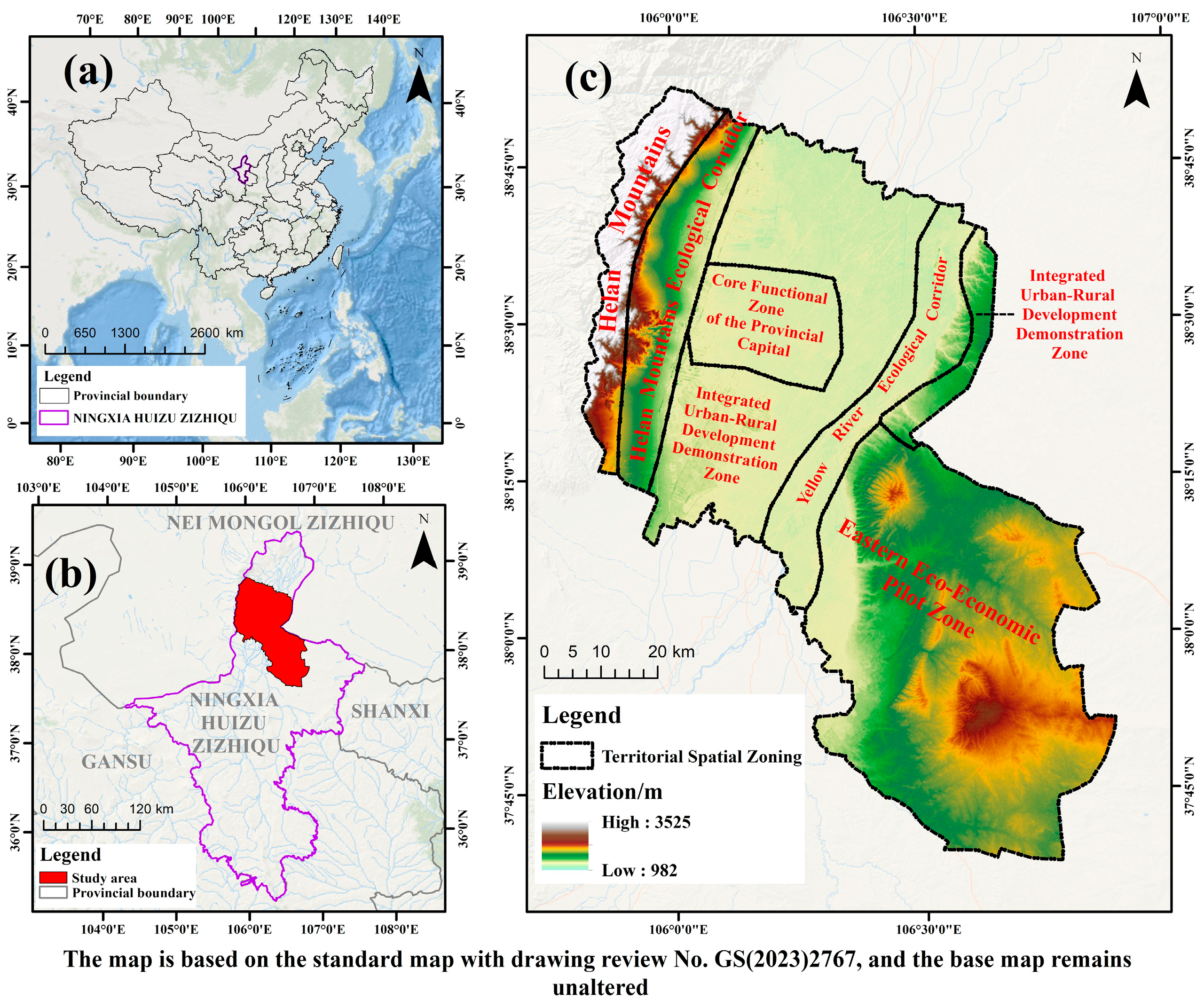
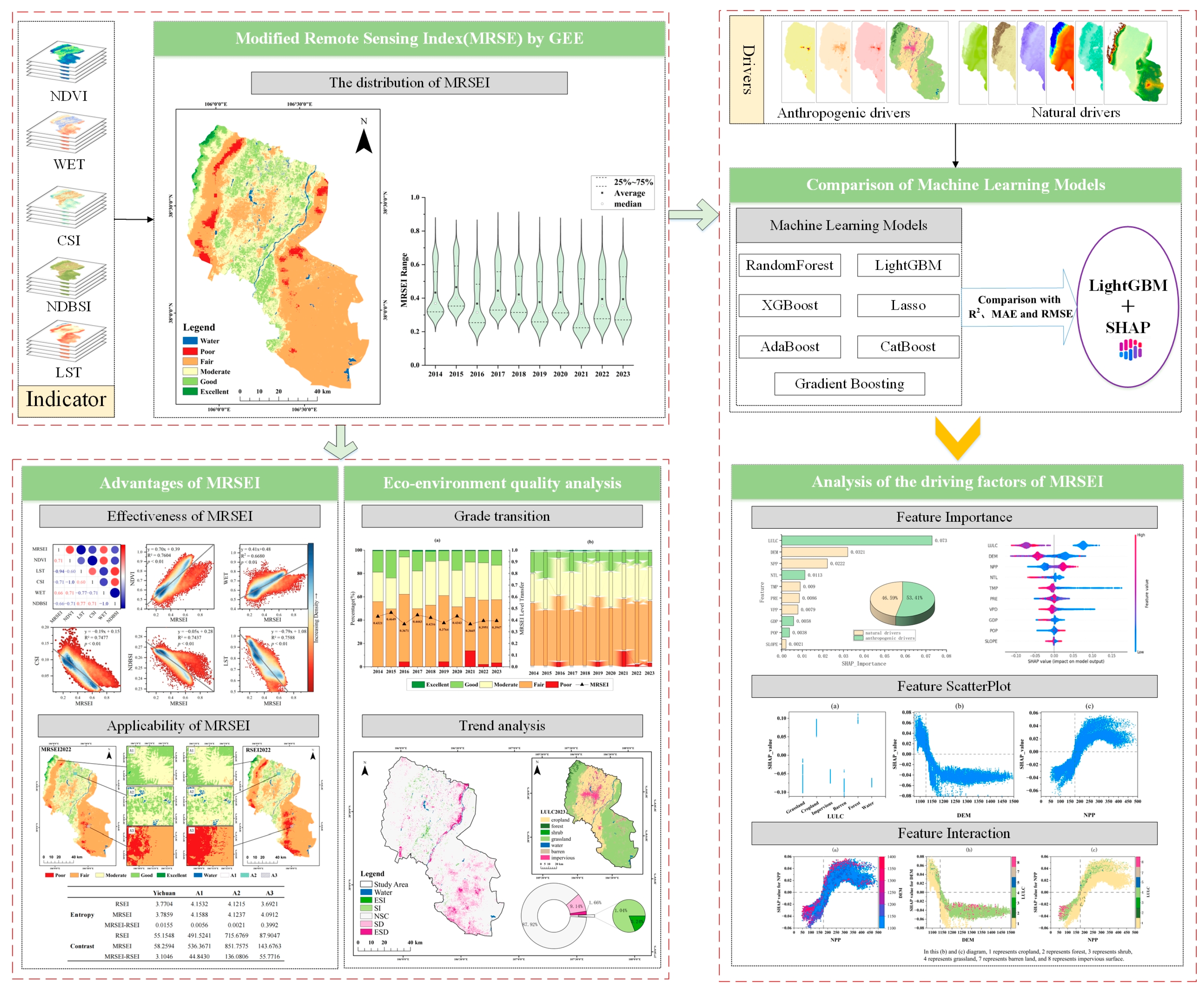
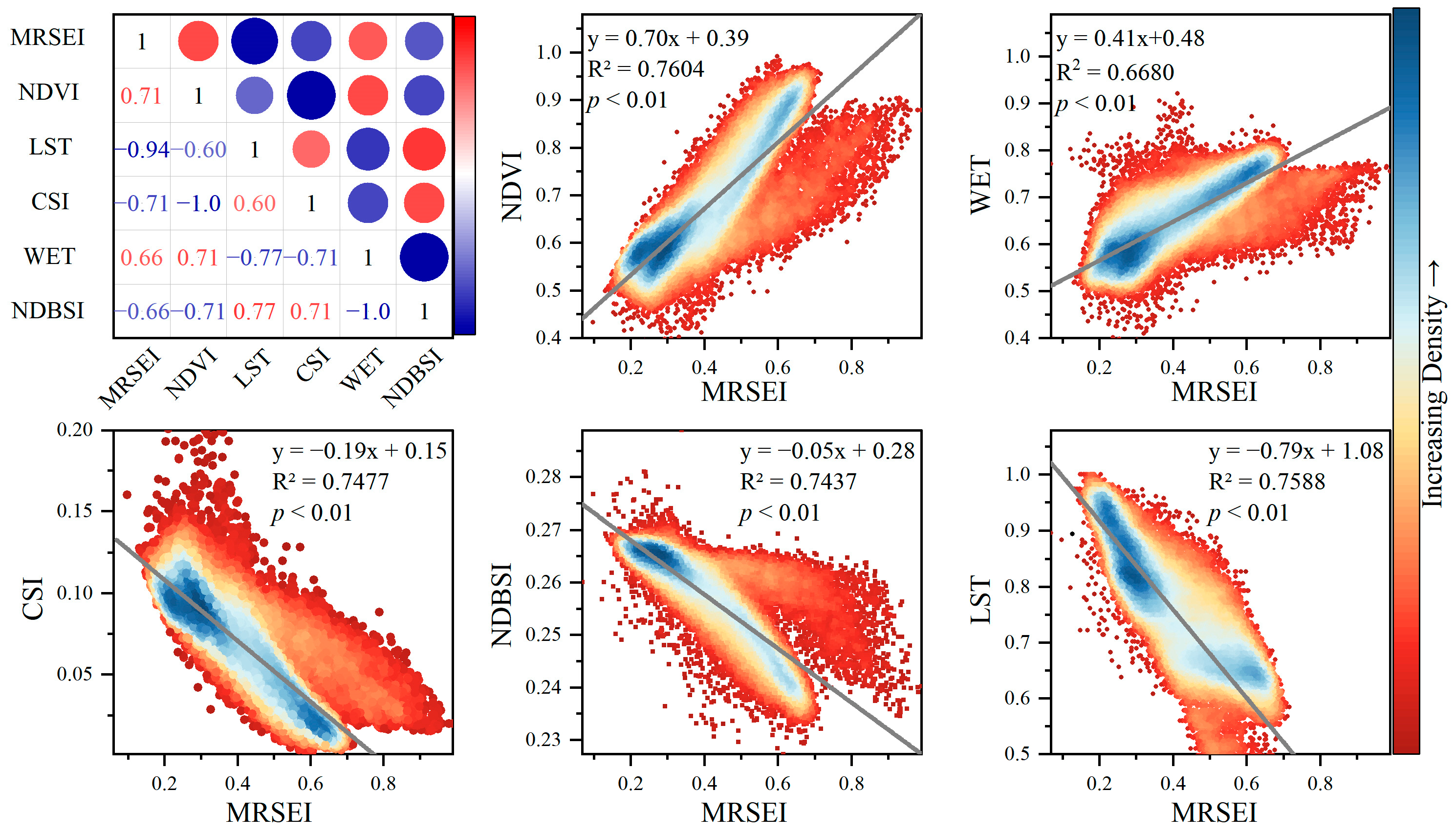
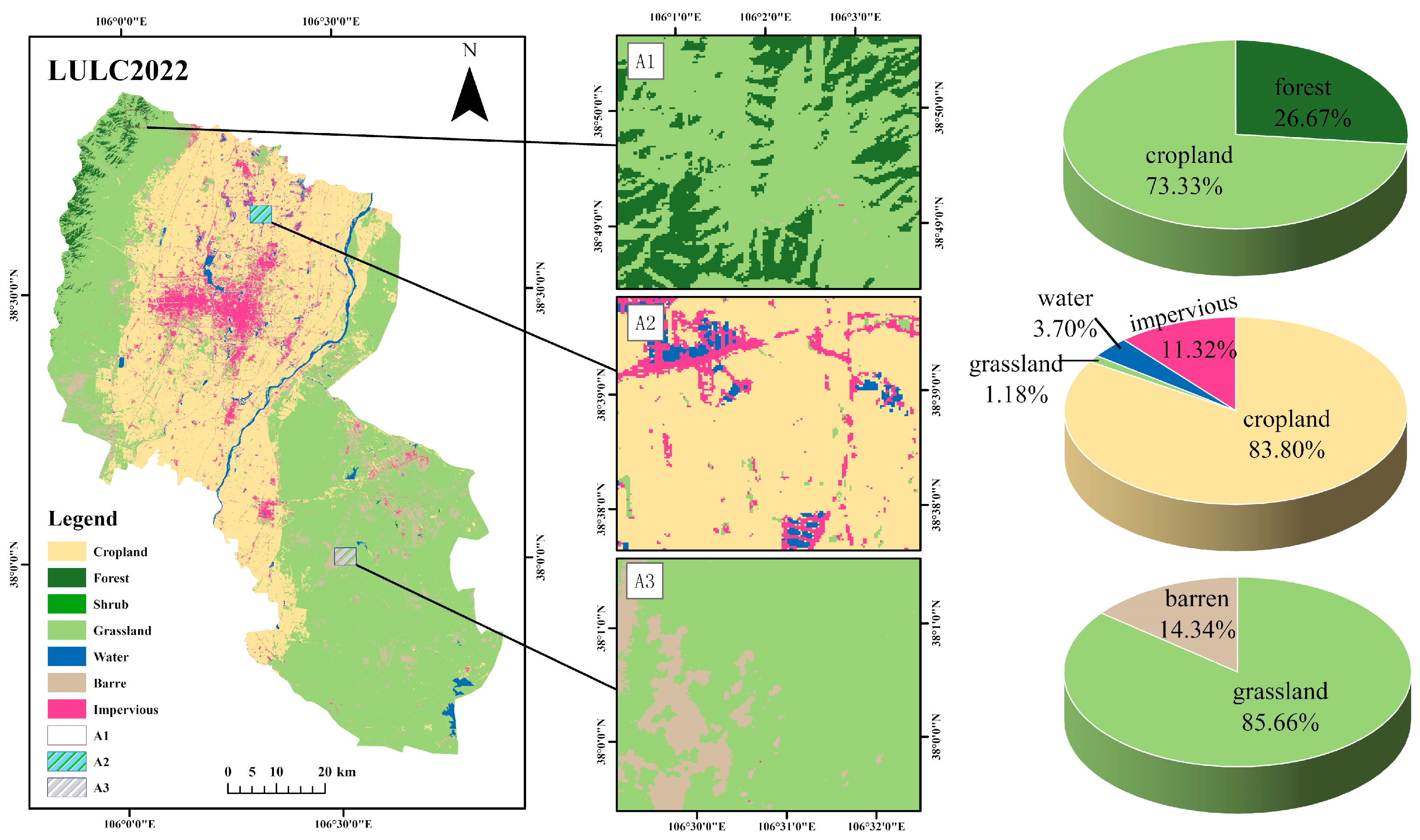
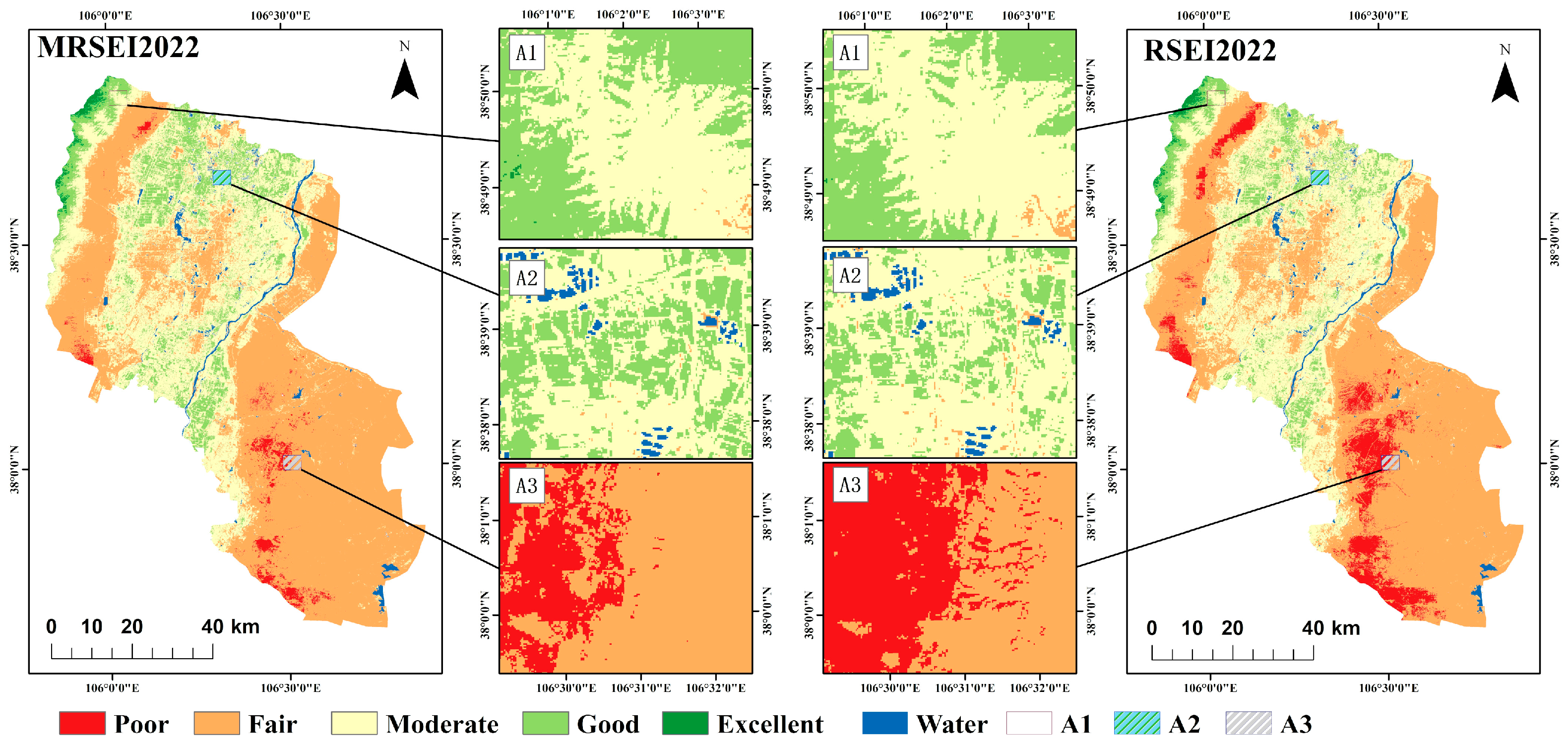
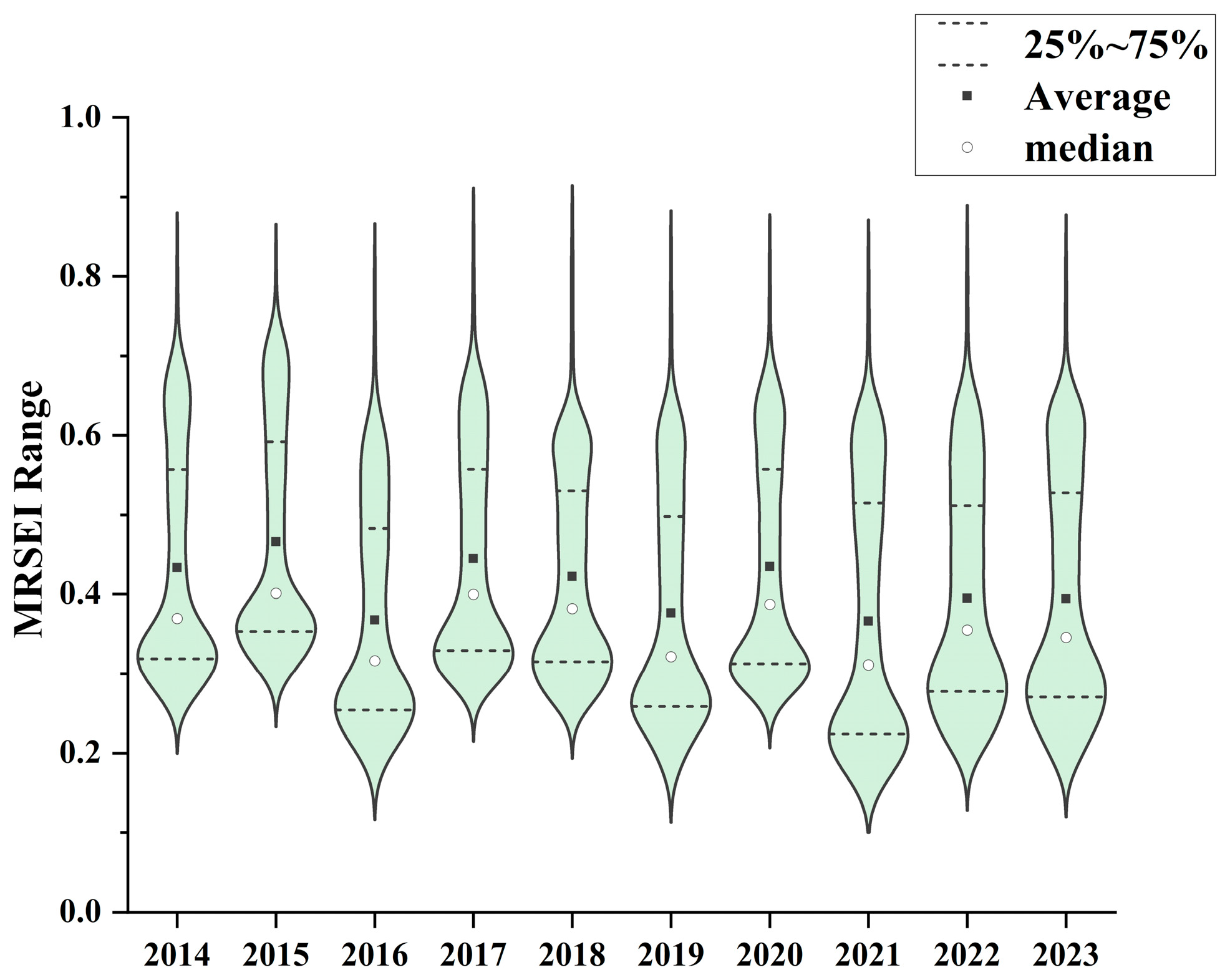

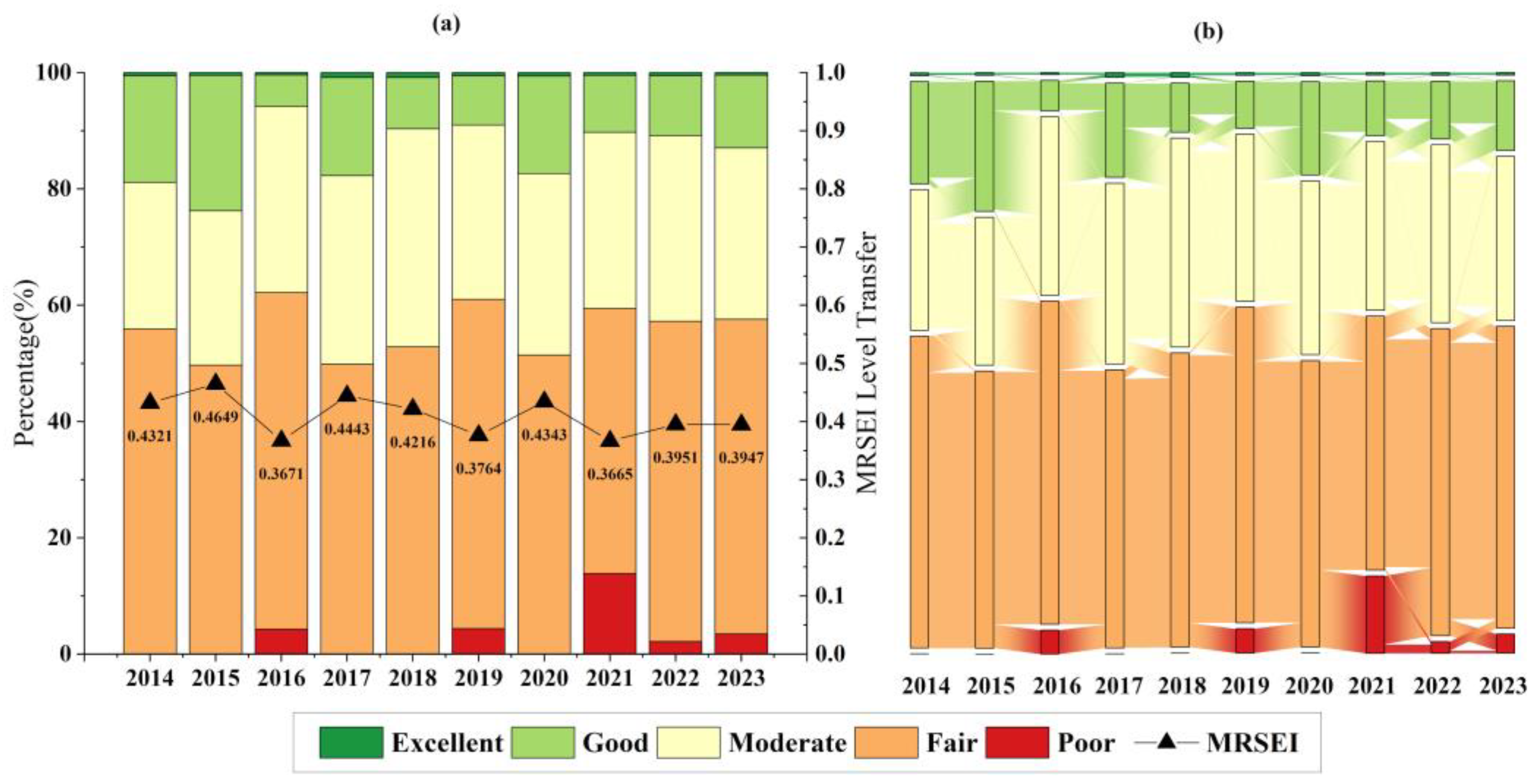
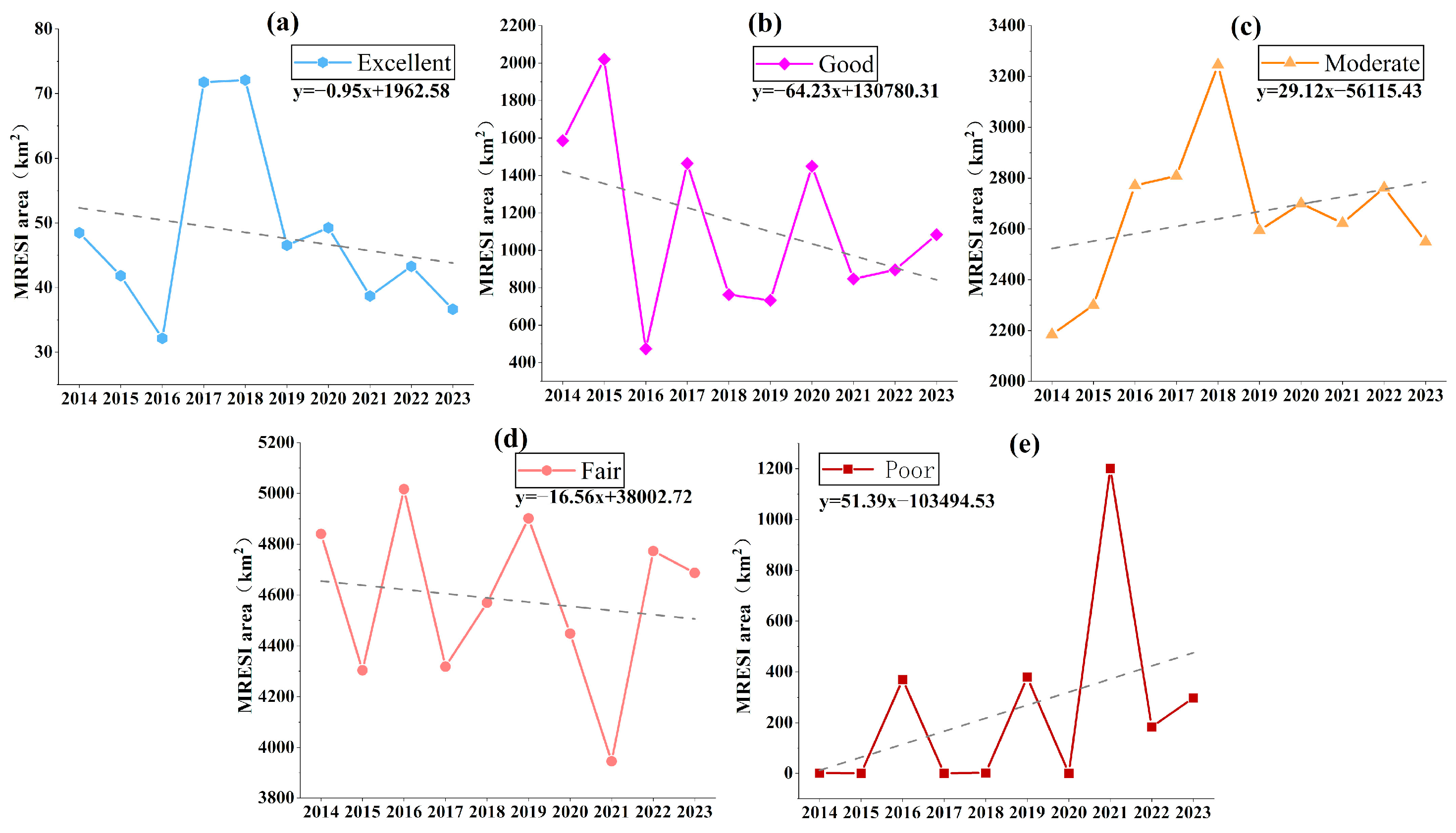
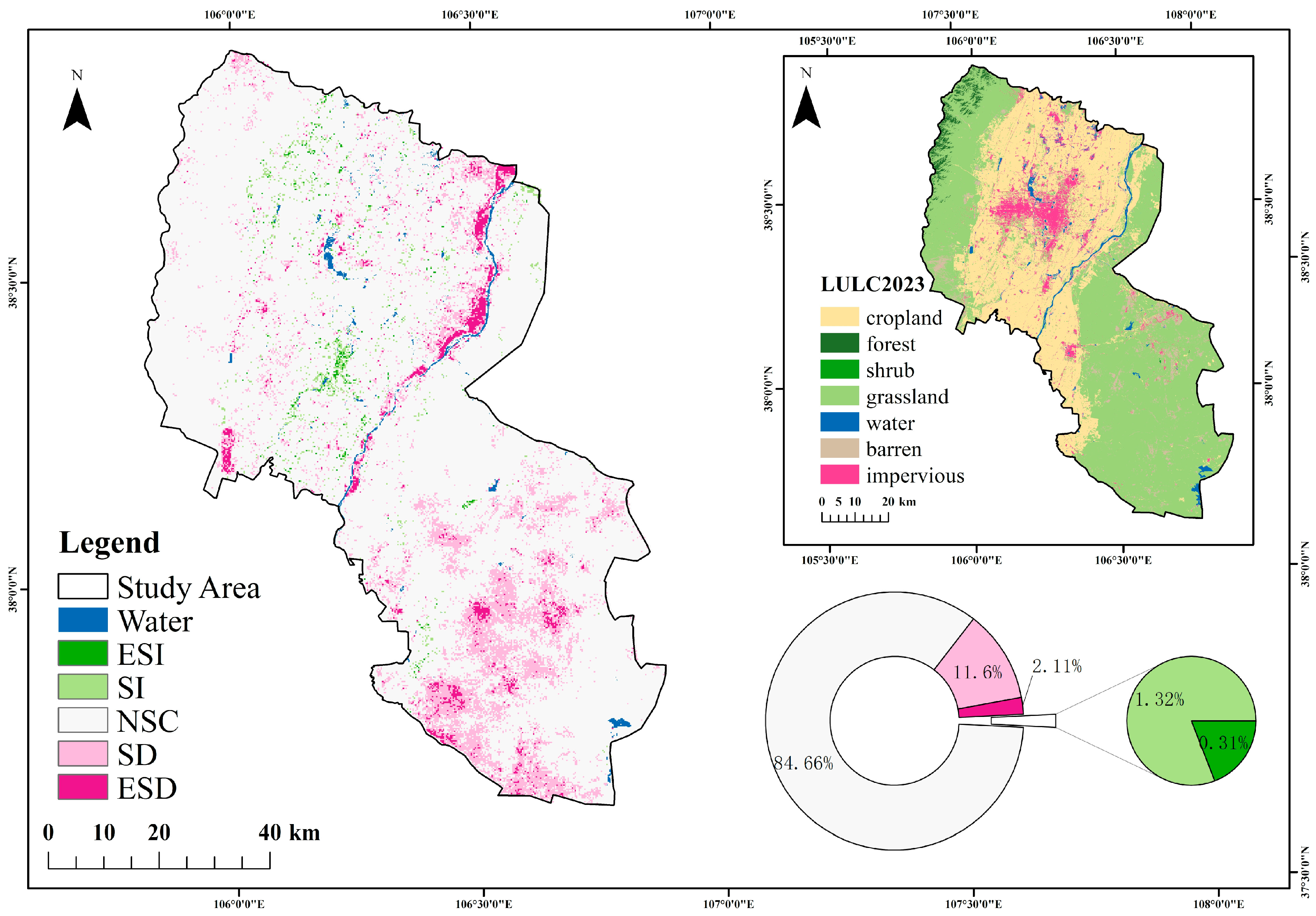
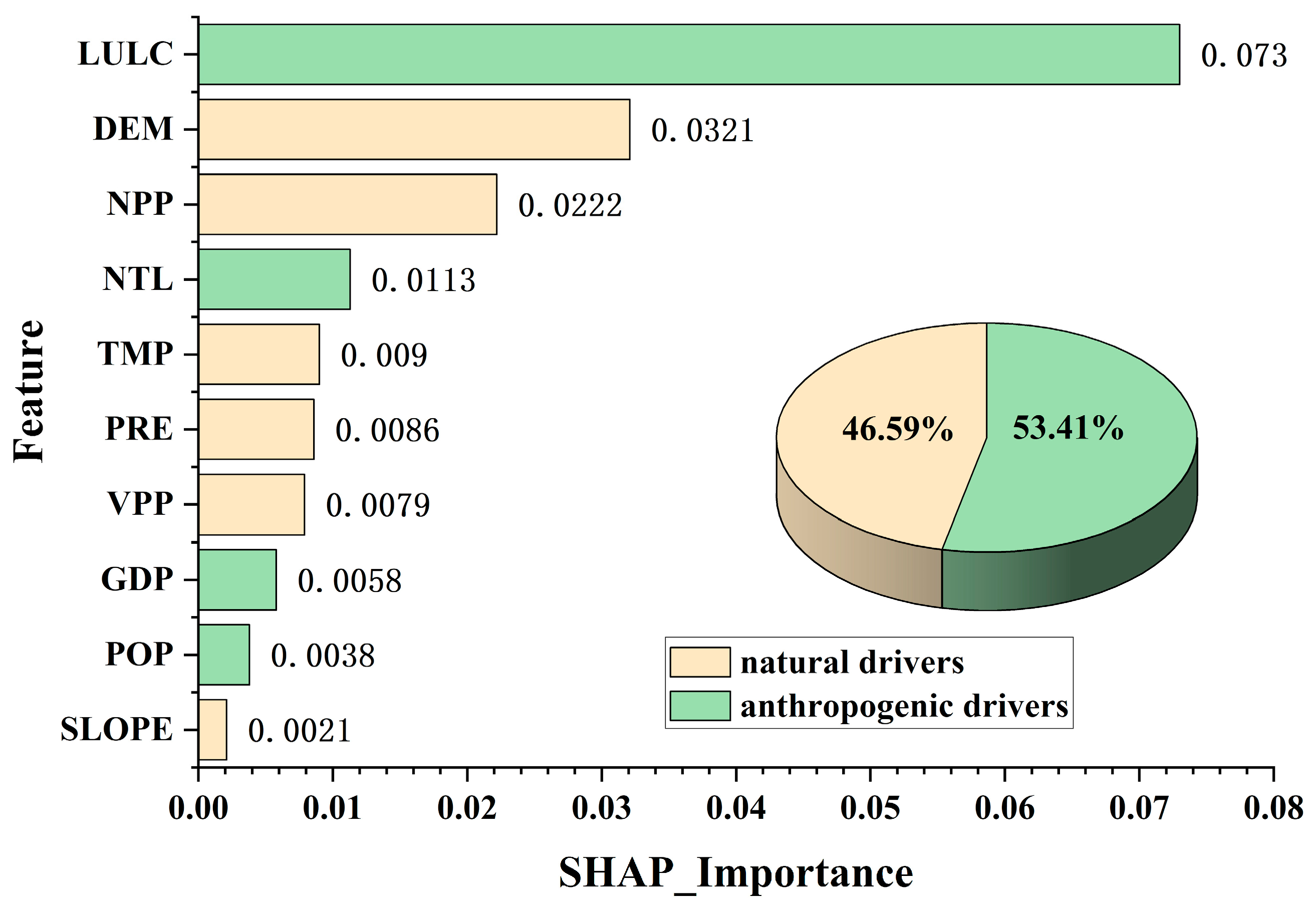
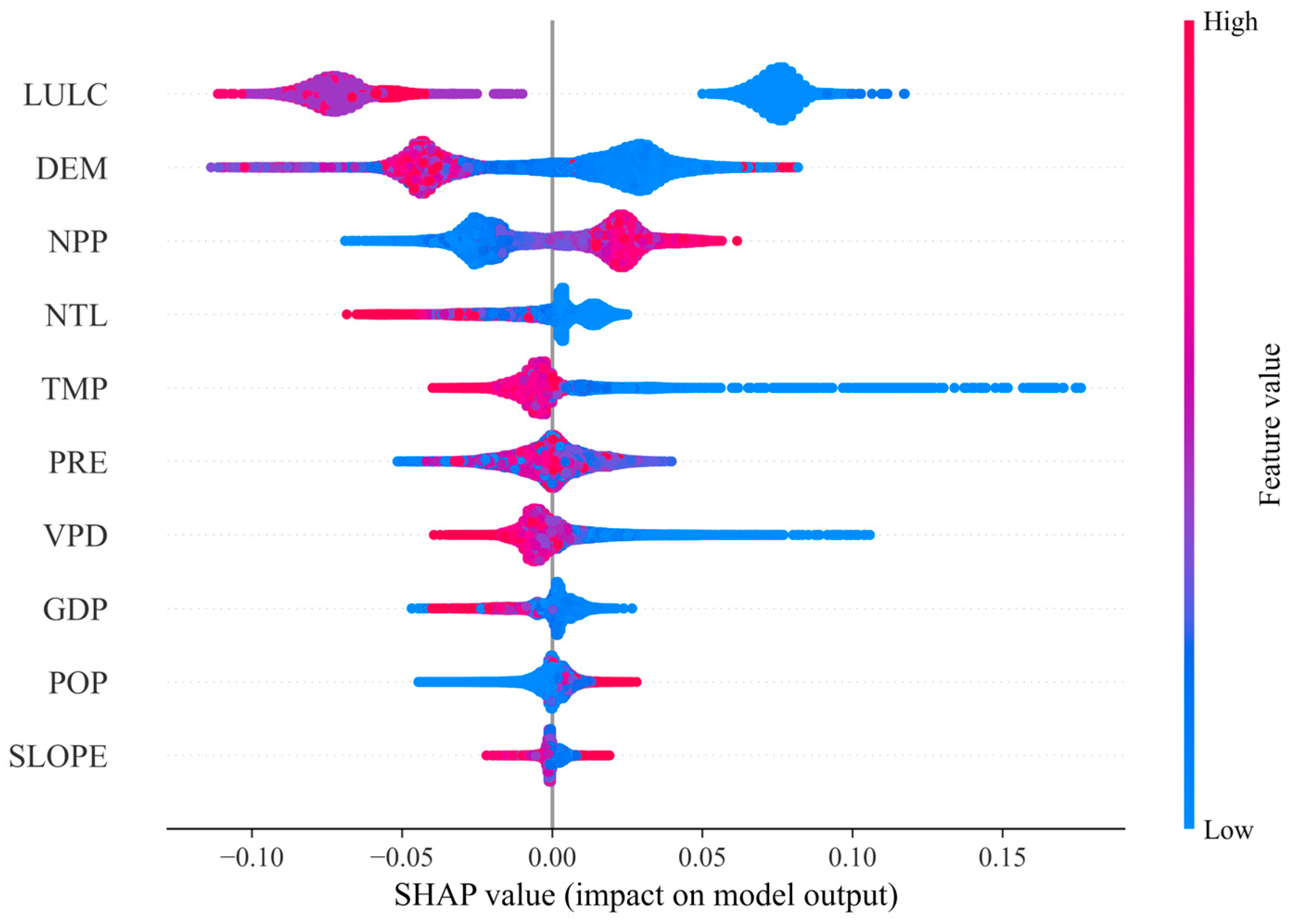
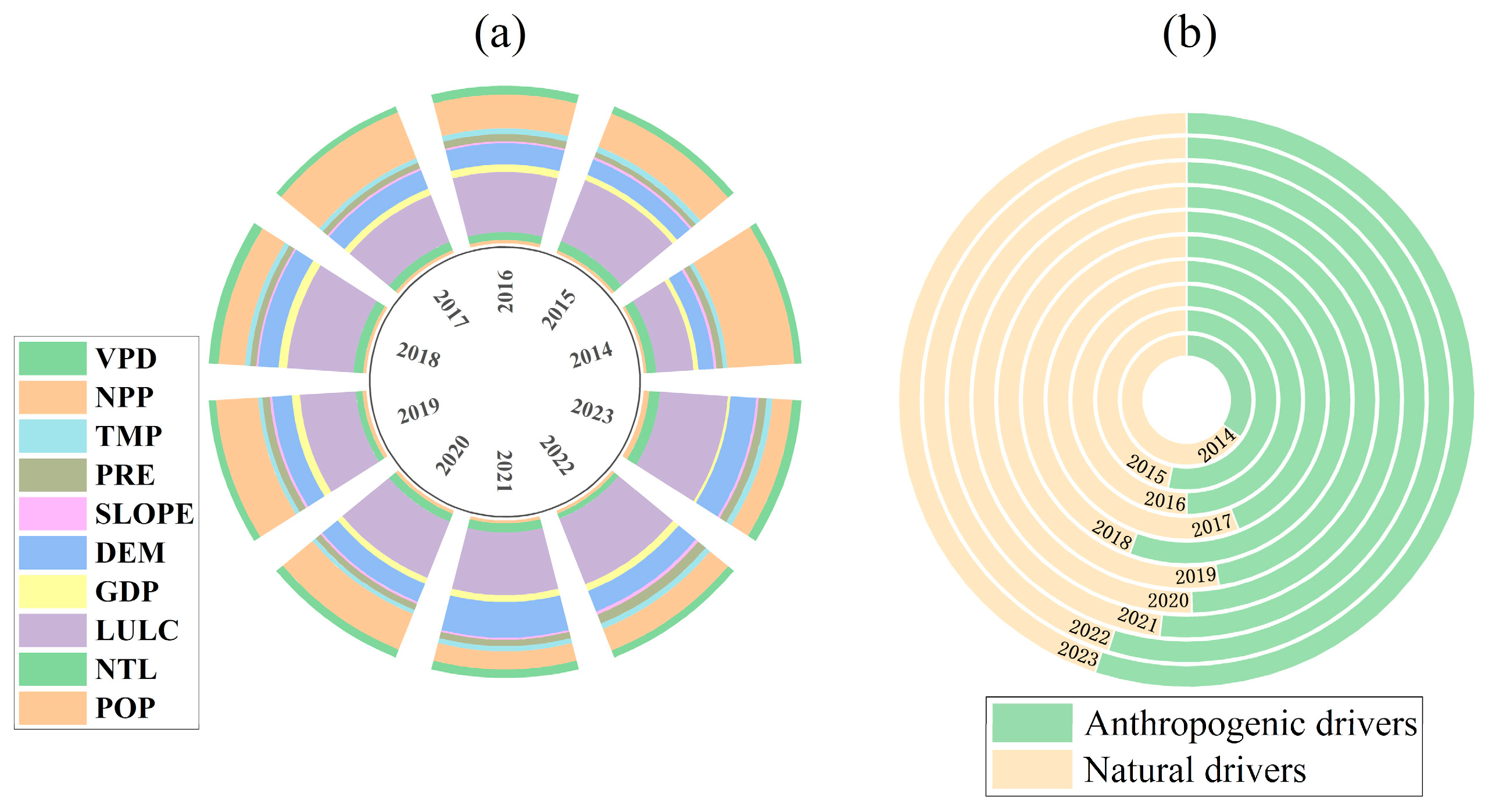


| Data Type | Data Name | Spatial Resolution | Source |
|---|---|---|---|
| RSEI/MRSEI | LANDSAT8 OLI | 30 m | https://developers.google.com |
| MOD11A2 | 1 km | https://developers.google.com | |
| anthropogenic drivers | POP | 1 km | https://landscan.ornl.gov |
| NTL | 1 km | https://dataverse.harvard.edu | |
| GDP | 1 km | https://www.resdc.cn | |
| LULC | 30 m | https://doi.org/10.5281/zenodo.4417809 | |
| natural drivers | PRE | 1 km | https://data.tpdc.ac.cn/home |
| TEM | 1 km | https://data.tpdc.ac.cn/home | |
| VPD | 1 km | https://data.tpdc.ac.cn/home | |
| DEM | 1 km | https://www.resdc.cn/ | |
| SLO | 1 km | https://www.resdc.cn/ | |
| NPP | 1 km | https://www.resdc.cn/ |
| Index | Calculation |
|---|---|
| NDVI | |
| WET | |
| NDBSI | |
| CSI |
| Trend | Significance | Trend Type | Trend Feature |
|---|---|---|---|
| Slope > 0 | |Z| > 2.58 | ESI | Extremely significant improvement |
| 1.96 < |Z| ≤ 2.58 | SI | Significant improvement | |
| |Z| ≤ 1.96 | NSC | No significant change | |
| Slope < 0 | |Z| ≤ 1.96 | NSC | No significant change |
| 1.96 < |Z| ≤ 2.58 | SD | Significant degradation | |
| |Z| > 2.58 | ESD | Extremely significant degradation |
| PC1 | NDVI | WET | CSI | NDBSI | LST | Percentage Variance |
|---|---|---|---|---|---|---|
| 2014 | 0.6578 | 0.2456 | −0.1152 | −0.0052 | −0.7026 | 81.82 |
| 2015 | 0.6643 | 0.1785 | −0.2451 | −0.0156 | −0.6830 | 82.94 |
| 2016 | 0.5045 | 0.2544 | −0.0008 | −0.3658 | −0.7395 | 77.43 |
| 2017 | 0.5812 | 0.2249 | −0.1851 | −0.0478 | −0.7583 | 81.49 |
| 2018 | 0.5813 | 0.2287 | −0.1342 | −0.0017 | −0.7693 | 75.6 |
| 2019 | 0.5836 | 0.3004 | −0.0102 | −0.0245 | −0.7539 | 79.49 |
| 2020 | 0.6340 | 0.2204 | −0.0768 | −0.0313 | −0.7366 | 82.7 |
| 2021 | 0.5673 | 0.1799 | −0.0698 | −0.0213 | −0.8003 | 84.85 |
| 2022 | 0.6075 | 0.3590 | −0.1629 | −0.0443 | −0.6881 | 74.51 |
| 2023 | 0.6158 | 0.2727 | −0.0475 | −0.0123 | −0.7376 | 78.72 |
| Yinchuan | A1 | A2 | A3 | ||
|---|---|---|---|---|---|
| Entropy | RSEI | 3.7704 | 4.1532 | 4.1215 | 3.6921 |
| MRSEI | 3.7859 | 4.1588 | 4.1237 | 4.0912 | |
| MRSEI-RSEI | 0.0155 | 0.0056 | 0.0021 | 0.3992 | |
| Contrast | RSEI | 55.1548 | 491.5241 | 715.6769 | 87.9047 |
| MRSEI | 58.2594 | 536.3671 | 851.7575 | 143.6763 | |
| MRSEI-RSEI | 3.1046 | 44.8430 | 136.0806 | 55.7716 |
| Poor | Fair | Moderate | Good | Excellent | |
|---|---|---|---|---|---|
| 2014 | 1.26 | 4840.82 | 2183.98 | 1585.89 | 48.48 |
| 2015 | 0.78 | 4303.52 | 2300.17 | 2019.89 | 41.83 |
| 2016 | 370.37 | 5016.77 | 2771.34 | 473.66 | 32.15 |
| 2017 | 0.84 | 4317.70 | 2808.68 | 1464.31 | 71.76 |
| 2018 | 1.53 | 4569.42 | 3245.58 | 762.99 | 72.10 |
| 2019 | 379.65 | 4901.68 | 2594.50 | 732.65 | 46.54 |
| 2020 | 0.10 | 4448.28 | 2699.92 | 1448.89 | 49.27 |
| 2021 | 1200.92 | 3945.34 | 2622.73 | 847.67 | 38.69 |
| 2022 | 183.78 | 4773.28 | 2762.33 | 895.54 | 43.28 |
| 2023 | 297.96 | 4686.68 | 2549.46 | 1083.56 | 36.66 |
| Trend Type | Area (km2) | Proportion |
|---|---|---|
| ESI | 21.1959 | 0.24% |
| SI | 89.8398 | 1.04% |
| NSI | 7609.2300 | 87.92% |
| SD | 790.6590 | 9.14% |
| ESD | 143.8580 | 1.66% |
| R2 | MAE | RMSE | |
|---|---|---|---|
| RF | 0.6873 | 0.0603 | 0.0751 |
| XGBoost | 0.6721 | 0.0619 | 0.0773 |
| AdaBoost | 0.6728 | 0.0617 | 0.0769 |
| CatBoost | 0.6838 | 0.0607 | 0.0759 |
| LightGBM | 0.6918 | 0.0596 | 0.0746 |
| Lasso | 0.4285 | 0.0821 | 0.1021 |
| GradientBoosting | 0.6881 | 0.0597 | 0.0749 |
Disclaimer/Publisher’s Note: The statements, opinions and data contained in all publications are solely those of the individual author(s) and contributor(s) and not of MDPI and/or the editor(s). MDPI and/or the editor(s) disclaim responsibility for any injury to people or property resulting from any ideas, methods, instructions or products referred to in the content. |
© 2025 by the authors. Licensee MDPI, Basel, Switzerland. This article is an open access article distributed under the terms and conditions of the Creative Commons Attribution (CC BY) license (https://creativecommons.org/licenses/by/4.0/).
Share and Cite
Zhang, B.; Yang, X.; Wang, M.; Cheng, L.; Hao, L. Quantifying Ecological Dynamics and Anthropogenic Dominance in Drylands: A Hybrid Modeling Framework Integrating MRSEI and SHAP-Based Explainable Machine Learning in Northwest China. Remote Sens. 2025, 17, 2266. https://doi.org/10.3390/rs17132266
Zhang B, Yang X, Wang M, Cheng L, Hao L. Quantifying Ecological Dynamics and Anthropogenic Dominance in Drylands: A Hybrid Modeling Framework Integrating MRSEI and SHAP-Based Explainable Machine Learning in Northwest China. Remote Sensing. 2025; 17(13):2266. https://doi.org/10.3390/rs17132266
Chicago/Turabian StyleZhang, Beilei, Xin Yang, Mingqun Wang, Liangkai Cheng, and Lina Hao. 2025. "Quantifying Ecological Dynamics and Anthropogenic Dominance in Drylands: A Hybrid Modeling Framework Integrating MRSEI and SHAP-Based Explainable Machine Learning in Northwest China" Remote Sensing 17, no. 13: 2266. https://doi.org/10.3390/rs17132266
APA StyleZhang, B., Yang, X., Wang, M., Cheng, L., & Hao, L. (2025). Quantifying Ecological Dynamics and Anthropogenic Dominance in Drylands: A Hybrid Modeling Framework Integrating MRSEI and SHAP-Based Explainable Machine Learning in Northwest China. Remote Sensing, 17(13), 2266. https://doi.org/10.3390/rs17132266








